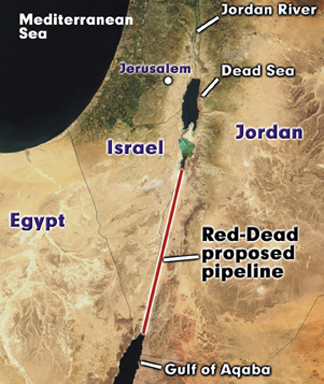
Geotimes Home | AGI Home | Information Services | Geoscience Education | Public Policy | Programs | Publications | Careers

 More than 400 meters
below sea level lie the calm waters of the Dead Sea. The saltiest major water
body on Earth, the Dead Sea stands between Israel and Jordan and marks an area
historically rich and scientifically significant. Its shores are the lowest point
of dry land on Earth, and keep getting lower — now shrinking about 1 meter
each year. In this region plagued by severe water shortages, scientists and politicians
are now trying to come together in a massive effort that would move water from
the Red Sea to the Dead Sea.
More than 400 meters
below sea level lie the calm waters of the Dead Sea. The saltiest major water
body on Earth, the Dead Sea stands between Israel and Jordan and marks an area
historically rich and scientifically significant. Its shores are the lowest point
of dry land on Earth, and keep getting lower — now shrinking about 1 meter
each year. In this region plagued by severe water shortages, scientists and politicians
are now trying to come together in a massive effort that would move water from
the Red Sea to the Dead Sea.  |
Geotimes Home | AGI Home | Information Services | Geoscience Education | Public Policy | Programs | Publications | Careers |